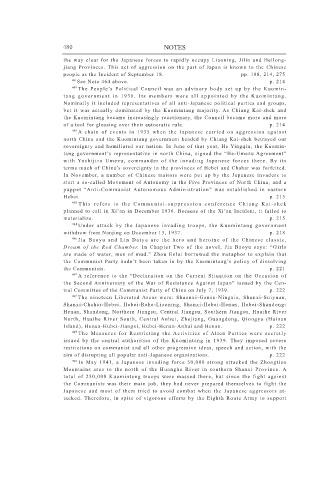Page 486 - SELECTED WORKS OF ZHOU ENLAI Volume I
P. 486
480 NOTES
the way clear for the Japanese forces to rapidly occupy Liaoning, Jilin and Heilong-
jiang Provinces. This act of aggression on the part of Japan is known to the Chinese
people as the Incident of September 18. pp. 188, 214, 275
491 See Note 464 above. p. 214
492 The People’s Political Council was an advisory body set up by the Kuomin-
t a n g g o v e r n m e n t i n 1 9 3 8 . I t s m e m b e r s we r e a l l a p p o i n t e d b y t h e Ku o m i n t a n g .
Nominally it included representatives of all anti-Japanese political parties and groups,
but it was actually dominated by the Kuomintang majority. As Chiang Kai-shek and
the Kuomintang became increasingly reactionary, the Council became more and more
of a tool for glossing over their autocratic rule. p. 214
A chain of events in 1935 when the Japanese carried on aggression against
492
north China and the Kuomintang government headed by Chiang Kai-shek betrayed our
sovereignty and humiliated our nation. In June of that year, He Yingqin, the Kuomin-
tang government’s representative in north China, signed the “He-Umezu Agreement”
with Yoshijiro Umezu, commander of the invading Japanese forces there. By its
terms much of China’s sovereignty in the provinces of Hebei and Chahar was forfeited.
In November, a number of Chinese traitors were put up by the Japanese invaders to
start a so-called Movement of Autonomy in the Five Provinces of North China, and a
puppet “Anti-Communist Autonomous Administration” was established in eastern
Hebei. p. 215
This refers to the Communist-suppression conference Chiang Kai-shek
493
planned to call in Xi’an in December 1936. Because of the Xi’an Incident, it failed to
materialize. p. 215
494 Under attack by the Japanese invading troops, the Kuomintang government
withdrew from Nanjing on December 13, 1937. p. 218
Jia Baoyu and Lin Daiyu are the hero and heroine of the Chinese classic,
495
Dream of the Red Chamber. In Chapter Two of the novel, Jia Baoyu says: “Girls
are made of water, men of mud.” Zhou Enlai borrowed the metaphor to explain that
the Communist Party hadn’t been taken in by the Kuomintang’s policy of dissolving
the Communists. p. 221
A reference to the “Declaration on the Current Situation on the Occasion of
496
the Second Anniversary of the War of Resistance Against Japan” issued by the Cen-
tral Committee of the Communist Party of China on July 7, 1939. p. 222
497 The nineteen Liberated Areas were: Shaanxi-Gansu-Ningxia, Shanxi-Suiyuan,
Shanxi-Chahar-Hebei, Hebei-Rehe-Liaoning, Shanxi-Hebei-Henan, Hebei-Shandong-
Henan, Shandong, Northern Jiangsu, Central Jiangsu, Southern Jiangsu, Huaihe River
North, Huaihe River South, Central Anhui, Zhejiang, Guangdong, Qiongya (Hainan
Island), Hunan-Hubei-Jiangxi, Hubei-Henan-Anhui and Henan. p. 222
498 The Measures for Restricting the Activities of Alien Parties were secretly
issued by the central authorities of the Kuomintang in 1939. They imposed severe
restrictions on communist and all other progressive ideas, speech and action, with the
aim of disrupting all popular anti-Japanese organizations. p. 222
499
In May 1941, a Japanese invading force 50,000 strong attacked the Zhongtiao
Mountains area to the north of the Huanghe River in southern Shanxi Province. A
total of 250,000 Kuomintang troops were massed there, but since the fight against
the Communists was their main job, they had never prepared themselves to fight the
Japanese and most of them tried to avoid combat when the Japanese aggressors at-
tacked. Therefore, in spite of vigorous efforts by the Eighth Route Army to support

